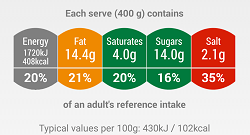The call comes after Action on Salt conducted a survey on 555 savoury picnic foods in the UK, of which 33% didn't feature front of pack colour-coded labels

Picnic table with surveyed food (Credit: Action on Salt)
Immediate compulsory front of pack nutritional labels need to be implemented for all food products, says UK-based group Action on Salt.
This comes after the scientists based at Queen Mary University of London found that one in four of the 555 savoury picnic foods tested were dangerously high in salt.
It also found that almost one in three of the products failed to display the recommended colour-coded front of pack labelling system, making it harder for consumers to purchase the healthier option.
Action on Salt nutritionist Mhairi Brown said: “This survey highlights just how easy it is for consumers to unknowingly eat huge amounts of salt and saturated fat hidden in savoury snacks and picnic favourites.
“Food manufacturers must get on board in our efforts to improve the nation’s health.
“We found a large variation in the salt content of product categories proving reformulation is easily achievable.
“We want to see the food industry disclosing nutritional information clearly on front of pack on all products so everyone can easily find healthier options.”
More than 30% of products with front of pack labels were high in saturated fat, Action on Salt’s survey discovered
In 2017, Public Health England set out a list of salt reduction targets for food and beverage items, with varying goals set for a wide range of products.
According to Action on Salt, of the 555 products it tested, 372 had the highest voluntary target set out by Public Health England, with 17% having more salt than their goal.
It found that some olive-based products contained double the salt concentration of seawater.
Action on Salt campaign lead Sonia Pombo said: “Picnics are a British favourite, but with all the different salty options on offer, it’s a sure way of upping your salt intake.
“Eating too much salt puts us at risk of suffering from heart disease or stroke, but we are all eating much more salt than the recommended limit of six grams per day, with salt intake in the UK averaging eight grams per day.
“The challenge facing consumers is that most of the salt in our diet is already present in the foods we buy and so the government must take action now and ensure the food industry improves the quality of their food for the benefit of our health.”
The group also found, of the 29% of products without colour-coded front of pack labelling, 40% were high in salt — which would result in a red warning label.
Many of these are olive products, which do not have a salt target.
Furthermore, 32% of the products with no front of pack labelling are high in saturated fat.

Graham MacGregor, professor of cardiovascular medicine at Queen Mary University of London and chair of Action on Salt, said: “Due to inaction by the Department of Health and Social Care and Public Health England in enforcing the 2017 salt reduction targets, the public are still eating more salt than recommended which is leading to thousands dying or suffering from entirely unnecessary strokes and heart disease.

“Reducing salt is one of the most cost-effective measures to protect health.
“The time has come for the secretary of state for health to resuscitate the UK’s salt reduction programme, helping us to, once again, be world leading rather than trailing behind the rest of the world.
“The public’s health has suffered long enough.”
